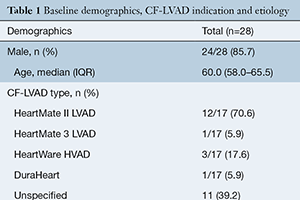Development of malignancies and their outcomes in patients supported on continuous-flow left ventricular assist devices—a systematic review
Abstract
Background: With increased use of continuous-flow left ventricular assist devices (CF-LVAD), development of malignant tumors in this population is not uncommon. We sought to evaluate malignancies in CF-LVAD patients and evaluate the outcomes of treatment strategies.
Methods: Overall, 18 articles consisting of 28 patients were identified who developed malignancies after CF-LVAD placement. Patient-level data were extracted for systematic review.
Results: Median patient age was 60 years [59–67] and 85.7% (24/28) were male. CF-LVAD was placed as bridge-to-transplant (BTT) in 60.9% (14/23) of patients. The three most common malignancy types were GI in 35.7% (10/28) of patients, lung in 21.4% (6/28) and skin in 10.7% (3/28). Median time from CF-LVAD implant to malignancy diagnosis was 6.9 [2.5–12.8] months. Metastatic disease occurred in 17.9% (5/28) over a median time of 5.0 [1.0–82.0] months from the diagnosis. Surgical resection of the malignancy was performed in 57.1% (16/28) of patients. Our results showed that while there was a significantly higher probability of survival among patients who underwent surgery versus those who did not, when only stage I and II patients were included in the analysis, this difference was no longer statistically significant. Three patients were relisted for heart transplant after surgical treatment, and two received the transplant.
Conclusions: Surgical management of malignancies in patients on CF-LVADs may improve survival and transplant eligibility status, therefore, a CF-LVAD should not always preclude surgical treatment.
Cover






